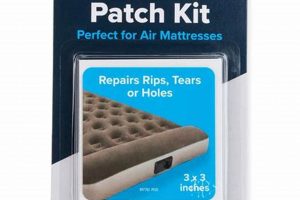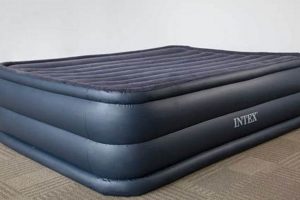Air mattress deflation refers to the loss of air pressure within an inflatable mattress, resulting in a reduction of firmness and support. This phenomenon can manifest gradually over time or occur rapidly, rendering the mattress less comfortable and potentially unusable. Observed examples range from a slight softening overnight to a complete collapse within minutes.
Addressing the underlying reasons for air loss is crucial for maintaining the utility and lifespan of the mattress. A fully functional air mattress provides portable and adaptable sleeping arrangements, proving beneficial for temporary guests, camping trips, or as a supplementary bed during home renovations. Identifying and rectifying the cause of pressure loss prevents the inconvenience of interrupted sleep and the premature need for replacement.
The following sections will explore the most common causes of air leakage, methods for identifying the source of the problem, and practical solutions to prolong the functional life of inflatable mattresses.
Addressing Air Mattress Deflation
Effective strategies exist to mitigate and prevent issues related to inflatable mattress pressure loss. Implementing these measures can significantly extend the lifespan and usability of the product.
Tip 1: Regularly Inspect the Valve: The valve is a primary point of potential leakage. Examine it for cracks, debris, or incomplete closure. Ensure the valve is properly sealed after each inflation.
Tip 2: Protect Against Punctures: Utilize the mattress on smooth, debris-free surfaces. A protective barrier, such as a blanket or tarp, can minimize the risk of punctures from sharp objects.
Tip 3: Avoid Overinflation: Inflating the mattress beyond its recommended capacity can stress the seams and material, leading to eventual air seepage. Refer to the manufacturer’s instructions for optimal inflation levels.
Tip 4: Monitor Ambient Temperature: Significant temperature fluctuations can affect air pressure within the mattress. Cold temperatures can cause the air to contract, resulting in perceived deflation. Conversely, heat can cause overexpansion.
Tip 5: Store Properly When Not In Use: When deflated, store the mattress in a cool, dry place away from direct sunlight and potential sources of damage. Fold or roll it carefully to avoid creating creases that could weaken the material.
Tip 6: Perform Soapy Water Test: Apply a soapy water solution to the mattress surface, particularly along seams and around the valve. Bubbles will form at the location of any air leaks.
Tip 7: Use a Patch Kit: For identified punctures or leaks, utilize the repair kit provided with the mattress or purchase a suitable patching material designed for inflatable products.
By consistently implementing these preventative measures and addressing issues promptly, the frequency and severity of air mattress deflation can be significantly reduced.
The final section will summarize the main points discussed and offer concluding thoughts on the ongoing maintenance of inflatable mattresses.
1. Puncture
A puncture, representing a breach in the air mattress’s outer membrane, directly correlates with subsequent air loss and the resultant deflation. This physical compromise, often caused by sharp objects or rough surfaces, creates an escape route for the compressed air contained within, thus initiating the deflation process. The size and nature of the puncture influence the rate of deflation; a small pinhole may cause a gradual loss over several hours, whereas a larger tear can lead to rapid and significant pressure reduction.
The material composition of the air mattress dictates its susceptibility to punctures. Thinner, less durable materials are more prone to penetration. Real-world examples include punctures sustained during camping trips from ground debris, or at home from pet claws. A failure to identify and repair even a minute puncture will invariably lead to complete deflation over time, rendering the mattress unusable until the breach is sealed. This reinforces the significance of regular inspection and the prompt application of appropriate repair techniques.
In summary, punctures represent a primary and common cause of air mattress deflation. Their impact is undeniable and directly influences the mattress’s ability to maintain air pressure. Understanding the connection between punctures and the overall problem of deflation emphasizes the necessity of preventative measures, such as using protective barriers and conducting thorough inspections, to preserve the integrity and utility of the inflatable mattress.
2. Valve Leakage
Valve leakage constitutes a significant factor contributing to the overall problem of air mattress deflation. The valve, designed to create an airtight seal, is the primary entry and exit point for air. Any compromise to its integrity directly impacts the mattress’s ability to maintain internal air pressure. Malfunctions can arise from a variety of causes, including physical damage to the valve components, the accumulation of debris preventing proper closure, or the gradual degradation of sealing materials over time. The consequence is a slow, often imperceptible, escape of air, leading to gradual deflation and a reduction in the mattress’s firmness and support.
The practical significance of valve integrity extends to the operational lifespan of the air mattress. An inadequate seal, even if initially minor, can progressively worsen with each inflation and deflation cycle. Examples range from a valve becoming cross-threaded during inflation, leading to thread damage and air seepage, to a small piece of grit lodging within the valve mechanism, disrupting the complete closure of the seal. Regular inspection of the valve, coupled with careful handling during inflation and deflation, can mitigate the risk of developing or exacerbating existing leaks. Cleaning the valve area to remove debris and ensuring proper threading alignment are simple yet effective preventative measures.
In summary, valve leakage directly and adversely affects an air mattress’s ability to retain air, ultimately contributing to the problem of deflation. Understanding the causes of valve-related issues, implementing preventative maintenance practices, and addressing leaks promptly are essential to extending the functional life of the mattress and ensuring consistent performance. The integrity of the valve is paramount to the mattress’s overall performance, thus requiring due diligence in its care and maintenance.
3. Seam Failure
Seam failure represents a critical structural weakness in air mattresses and is a primary contributo
r to the phenomenon of pressure loss. These seams, where different sections of the mattress material are joined, are inherently vulnerable to stress and degradation over time, leading to air leaks and eventual deflation. Understanding the mechanisms behind seam failure is crucial in comprehending the broader issue of why inflatable mattresses lose air.
- Material Degradation
The adhesive or welding used to create the seams can weaken due to prolonged exposure to environmental factors such as ultraviolet radiation or fluctuations in temperature. This degradation reduces the bond strength, creating microscopic pathways for air to escape. An older mattress, stored improperly, may exhibit significant seam separation compared to a newer model kept in optimal conditions.
- Stress Concentration
Seams are typically areas where stress is concentrated during inflation and use. Repeated inflation and deflation cycles, coupled with the weight of a user, can lead to fatigue and eventual tearing or separation of the material at the seams. Mattresses regularly used above their weight capacity are particularly susceptible to this type of failure.
- Manufacturing Defects
Imperfections during the manufacturing process, such as inadequate adhesive application or incomplete welding, can create inherent weaknesses in the seams. These defects may not be immediately apparent but can manifest over time, leading to premature failure. Such defects are often more prevalent in lower-quality or mass-produced air mattresses.
- Abrasion and Friction
Repeated rubbing against flooring or other surfaces can weaken the seams over time, particularly if the mattress lacks protective edging or is used on abrasive surfaces. This friction gradually wears down the seam material, increasing the likelihood of air leakage. Camping mattresses are especially at risk due to the uneven and potentially rough terrain.
The interplay of these factors ultimately determines the lifespan of an air mattress and its resistance to deflation. While some seam failures may be repairable, extensive separation often necessitates replacement of the entire unit. Understanding the susceptibility of seams to degradation and stress is crucial for selecting appropriate air mattresses, employing proper usage practices, and mitigating the impact of environmental factors to prolong the functional life of the product. The integrity of the seams directly governs the mattress’s ability to maintain air pressure, highlighting the critical connection between seam failure and overall deflation issues.
4. Temperature Change
Fluctuations in ambient temperature exert a demonstrable influence on the internal air pressure within an air mattress, contributing to the perception of deflation. The gas laws governing the behavior of air dictate a direct relationship between temperature and pressure; as temperature decreases, the pressure exerted by the air within the sealed environment of the mattress also diminishes.
- Gas Law Effects
The ideal gas law (PV=nRT) elucidates the connection between temperature, pressure, and volume of a gas. At constant volume, a decrease in temperature directly reduces the pressure. For instance, an air mattress inflated to a specific pressure at room temperature (e.g., 22C) will exhibit a measurable pressure decrease if the temperature drops significantly overnight (e.g., to 15C). This pressure drop results in a softer feel, often mistaken for a leak.
- Nocturnal Temperature Variation
Commonly, ambient temperatures decrease during nighttime hours. This effect is more pronounced in outdoor environments or poorly insulated rooms. As the air surrounding the mattress cools, the air inside the mattress loses thermal energy, leading to a contraction in volume and a reduction in pressure. Individuals may experience a seemingly deflated mattress upon waking, even if no actual air leakage has occurred. Real-world examples include camping scenarios where daytime inflation provides a firm mattress that becomes noticeably softer by morning due to the drop in overnight temperatures.
- Expansion and Contraction Cycles
Repeated temperature cycles can exacerbate the effects of pressure variation. Each increase in temperature leads to air expansion and increased pressure, potentially stressing the seams and valve. Conversely, each decrease in temperature results in contraction and reduced pressure. Over time, these repeated expansion and contraction cycles can weaken the mattress materials and contribute to gradual air leakage, compounding the perceived deflation.
- Material Properties and Heat Transfer
The material composition of the air mattress influences the rate of heat transfer. Thinner materials allow for faster heat exchange with the surrounding environment, resulting in more rapid temperature changes within the mattress. This rapid temperature fluctuation can lead to more noticeable and immediate pressure variations compared to mattresses constructed from thicker, more insulating materials. The specific heat capacity of the mattress material, a measure of its ability to store thermal energy, further contributes to the rate of temperature change within the mattress.
These facets collectively illustrate how ambient temperature changes directly impact the air pressure within an inflatable mattress. While the observed softening may be attributed to an actual leak, it is frequently a result of the natural gas laws governing air behavior. Understanding this phenomenon allows for more informed assessment and mitigation of perceived deflation issues, potentially avoiding unnecessary repair efforts.
5. Over-Inflation
Over-inflation constitutes a significant factor contributing to air mattress deflation. Exceeding the recommended air capacity places undue stress on the internal structure of the mattress, leading to a cascade of potential problems that ultimately compromise its ability to retain air. This excess pressure weakens seams, stretches the material beyond its elastic limit, and increases the risk of valve failure, each of which contributes to eventual air loss and deflation. Manufacturers specify maximum inflation levels to account for material properties and structural integrity; disregarding these guidelines invites premature degradation and failure.
The consequences of over-inflation manifest in several ways. Seams, being the weakest points in the mattress construction, are particularly susceptible to damage. The increased internal pressure forces the seam edges outward, potentially causing separation or tearing. Similarly, the mattress material itself can undergo irreversible stretching, diminishing its ability to maintain a tight seal around the valve or seams. A common example involves inflating the mattress until it feels “rock solid,” a practice that often exceeds the recommended pressure and accelerates material fatigue. Furthermore, over-inflation can compromise the valve mechanism. Constant pressure can distort the valve seal or damage the internal components, leading to a slow, continuous leak. This is particularly relevant in mattresses with integrated pumps, where users may inadvertently exceed the pressure limit.
In summation, over-inflation directly undermines the structural integrity of an air mattress, predisposing it
to a higher risk of deflation. Adhering to manufacturer guidelines regarding inflation levels is crucial for maximizing the mattress’s lifespan and ensuring consistent performance. The relationship between excessive pressure and component failure underscores the importance of diligent inflation practices to mitigate the long-term effects of over-inflation and prevent premature deflation.
6. Material Degradation
Material degradation, the progressive decline in the physical properties of the materials composing an air mattress, serves as a primary factor in the phenomenon of deflation. This degradation weakens the structure, compromising its ability to retain air pressure. The cause of material degradation varies, encompassing exposure to ultraviolet radiation, hydrolysis (reaction with moisture), oxidation, and mechanical stress from repeated inflation and deflation cycles. The effect is a gradual loss of elasticity and tensile strength, leading to increased permeability and susceptibility to leaks. For example, prolonged exposure to direct sunlight can embrittle PVC, a common material in air mattresses, causing it to crack and leak.
The practical significance of understanding material degradation lies in its impact on product lifespan and maintenance. Identifying the specific degradation mechanisms at play informs appropriate storage and usage practices. Regular cleaning to remove moisture and prevent mold growth, protection from direct sunlight, and careful handling during inflation and deflation can all mitigate the rate of material degradation. Selecting mattresses constructed from more durable, UV-resistant materials offers enhanced longevity. An instance demonstrating this involves comparing two similar air mattresses, one stored outdoors uncovered and the other indoors; the outdoor mattress will exhibit accelerated degradation and earlier deflation due to increased UV exposure and temperature fluctuations.
In conclusion, material degradation represents an unavoidable process that directly contributes to the deflation of air mattresses. Its impact is determined by the material’s inherent properties, the environmental conditions it is exposed to, and the frequency and intensity of use. Proactive measures to minimize degradation are essential for extending the functional life of the mattress and ensuring its continued ability to provide a reliable and comfortable sleeping surface.
Frequently Asked Questions
The following questions address common inquiries and concerns related to the loss of air pressure in inflatable mattresses, providing concise explanations and practical guidance.
Question 1: What are the most frequent causes of air loss in an air mattress?
The primary factors include punctures from sharp objects, leaks around the valve mechanism, seam failures due to stress or material degradation, temperature-induced pressure variations, over-inflation leading to material fatigue, and general material degradation from age and environmental exposure.
Question 2: How can the source of an air leak be identified?
A common method involves applying a soapy water solution to the inflated mattress surface, particularly around seams and the valve. The formation of bubbles indicates the location of an air leak. Visual inspection for punctures or tears is also recommended.
Question 3: Is it normal for an air mattress to lose some air overnight?
A slight reduction in air pressure overnight can be expected due to decreases in ambient temperature. However, significant deflation suggests a leak or other underlying issue requiring investigation.
Question 4: Can an over-inflated air mattress be repaired if it develops a leak?
The repairability of an over-inflated mattress depends on the extent of the damage. Small punctures or seam separations may be patchable, but extensive damage due to material stretching or valve failure may render the mattress irreparable.
Question 5: What storage practices can prolong the life of an air mattress and minimize deflation?
Proper storage involves deflating the mattress completely, cleaning and drying it thoroughly, folding or rolling it carefully to avoid sharp creases, and storing it in a cool, dry location away from direct sunlight and extreme temperatures.
Question 6: What are the indicators that an air mattress should be replaced rather than repaired?
Replacement is generally advisable when the mattress exhibits widespread material degradation, multiple irreparable leaks, significant seam separation, or a malfunctioning valve that cannot be adequately sealed or replaced.
These FAQs offer guidance on understanding the causes and remedies for air mattress deflation. Consistent maintenance and prompt attention to potential problems are key to prolonging the useful life of inflatable mattresses.
The subsequent section will provide a concluding summary of best practices for maintaining air mattresses.
Conclusion
This exposition has comprehensively explored the multifaceted reasons underlying air mattress deflation. Punctures, valve leakage, seam failure, temperature fluctuations, over-inflation, and material degradation all contribute to the gradual or rapid loss of air pressure. Consistent inspection, proper inflation practices, appropriate storage, and prompt repair efforts are essential for maximizing the lifespan and usability of inflatable mattresses.
Addressing the factors that cause air mattress pressure loss proactively ensures prolonged functionality and minimizes inconvenience. Continued diligence in maintenance remains crucial for retaining the utility of these versatile sleeping solutions, thereby extending their economic and practical value.







